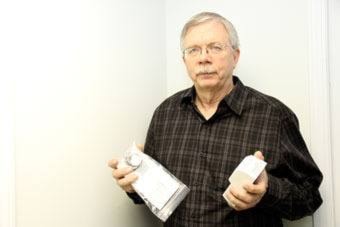In 10 years, Dana Schmidt hopes to eliminate Castlegar’s radon problem through education and prevention.
When Schmidt’s wife, Donna, passed away of lung cancer two years ago, he took it upon himself to research different causes of the disease.
He found Castlegar had the highest rate of radon gas in the province (the first is Clearwater) and it’s the second leading cause of lung cancer after smoking.
He started the Donna Schmidt Memorial Radon Abatement Fund to inform people about the risk of radon and the effect of lung cancer and to help people detect radon in their homes.
Radon is a colourless, odorless and tasteless gas found in the granite and rock around Castlegar. It occurs naturally as the decay product of uranium and flows through gravel into the air.
Through testing, Schmidt says 46 per cent of Castlegar’s homes are above Canadian standards and 57 per cent are above U.S. Environmental Protection Agency standards.
Some homes, he said, are 60 or 70 times the standard.
“There is no safe community or safe neighbourhood,” he said. “You really can’t tell until you test.”
Over the last two years, close to 1,000 test kits have been distributed throughout Castlegar. The kits Schmidt distributes for free stay in your house for a minimum of 90 days and are then evaluated.
Despite having almost half of the radon detectors coming back with values over the standard, Schmidt suspects less than 10 per cent of people will do anything about it.
He thinks this is because the “only” problem that comes with high exposure is lung cancer.
However, he points out that people have so much fire prevention equipment in their homes, yet you’re 100 times more likely to die from radon-related lung cancer than fire.
Schmidt says the lung cancer caused from radon is difficult to detect because the tumour starts out very small (he said if his wife would’ve had a chest X-ray when the tumour first started it would’ve come out clear) and it’s only detected once it’s spread – and by then it’s too late.
“The radon gas is relatively radioactive,” he said. “Once you breathe it in, it turns into a solid.”
Due to the dangers of radon, Schmidt is committed to educating people about the levels of gas in their homes and showing them what they can do to bring the levels down.
Currently, he’s working on brochures for homeowners and potential homeowners that he hopes to distribute to local realtors so those in the market to buy a house know the levels of radon in the house.
It’s a short commitment of time to have your house retrofitted for radon protection too.
“Radon-resistant construction is really what’s needed,” he said.
By sealing the floor, gas can’t come through the foundation. Radon can also be vented from the home through the use of small air pipes that go through the house and exit above the windows so the gas doesn’t come back through into the house. A fan above the pipe blows the gas away from the house.
Schmidt says the cost in electricity to mitigate the radon in a home is about $40, and the installation costs about $500 for a new house and $2,000 for a house that’s already built.
The next project Schmidt is taking on is through the city’s evening Rotary Club, of which he’s the president.
The club will provide the funds for someone to retrofit their home if they’re five times over the accepted amount and aren’t able to afford the renovations.
Schmidt said he’ll continue to provide the tests as long as there is a demand for them. They’re available through Schmidt at Golder Associates (201 Columbia Ave.), any Rotary Club member or at city hall.
Schmidt says it’s a small price to pay to prevent lung cancer.
“This is one of these issues where ignorance can kill you.”
